
Cambodia is located in the south-east asia region bordered by Thailand, Laos, and Vietnam. Being almost 2 millennia old, Cambodia as a country has had a long and rich history, heritage, culture, and nature. Having gone through the worst genocide of its history, Cambodia is, to this day, trying to move past its painful past. Despite the Pol Pot Regime, Cambodia continues to smile. After overcoming the tragedy, the Khmer land welcomes the new era with peace and grace and is becoming known as “The Land of Smiles” for its gentle and kind people.
Cambodia as a destination offers a variety of attractions for visitors, from the ancient temples of Angkor to the vibrant capital of Phnom penh, the pristine beaches of the south west and the beautiful lush jungle of the north east, Cambodia is full of diversities.
In this article, we will explore some of those aspects together.
Angkor: The Legacy of an Empire
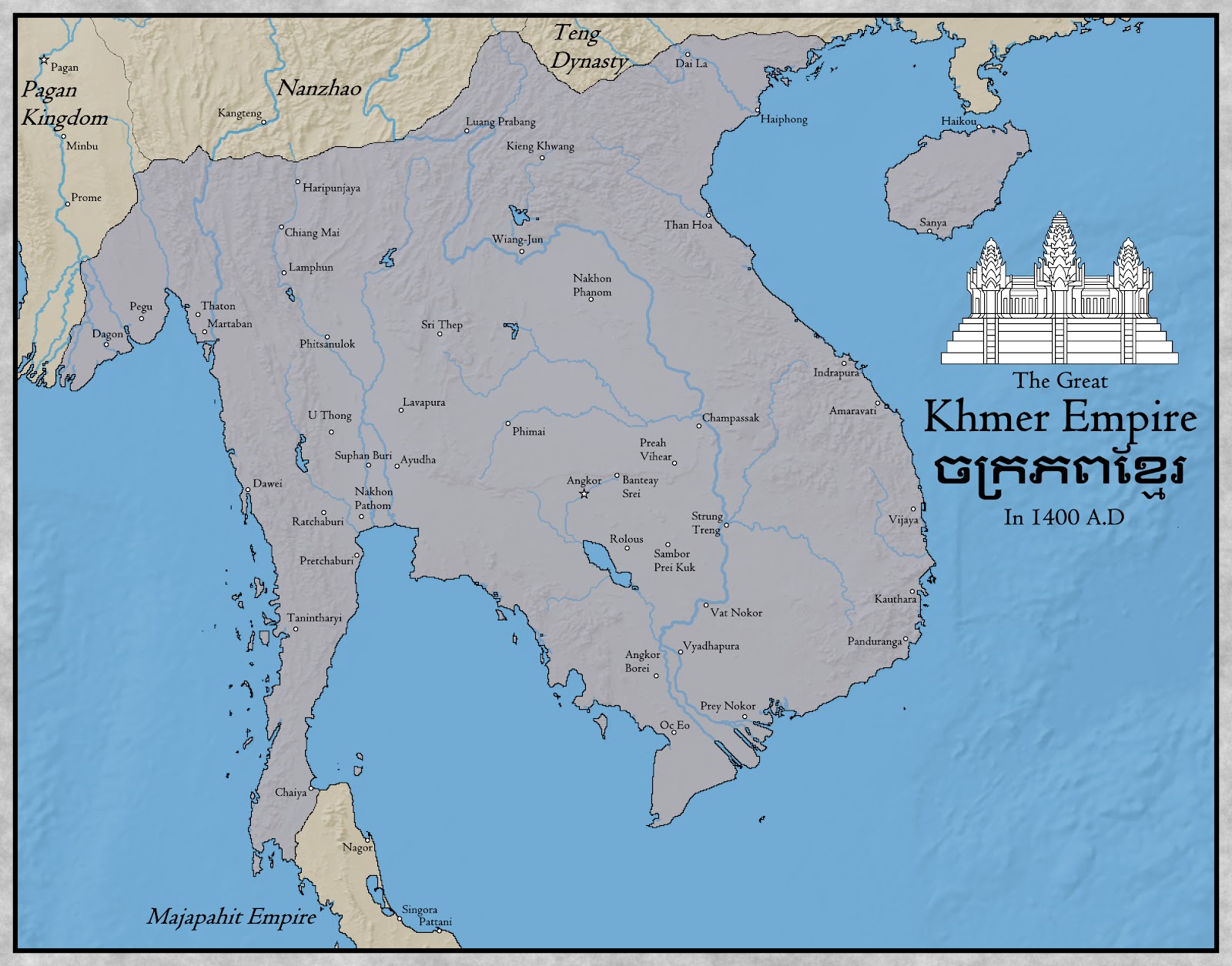
Cambodia is home to one of the most iconic and impressive sights in the world: the Angkor World Heritage Site. This site was the capital of the Khmer Empire, which ruled much of Southeast Asia from the 9th to the 15th centuries. The Khmer kings built hundreds of temples, palaces, and reservoirs that showcase their remarkable legacy of architecture, art, and engineering. In this article, we will explore three of the most famous and impressive temples at Angkor: Angkor Wat, Bayon, and Banteay Srei.
Angkor Wat
Angkor Wat is the largest religious monument in the world, covering an area of about 200 hectares (500 acres). It was built between 1122 and 1150 by King Suryavarman II as a Hindu temple dedicated to Vishnu. He was a powerful and ambitious ruler who expanded the empire through military conquests and diplomatic alliances. Angkor Wat is renowned for its intricate carvings, soaring towers, and symmetrical layout. It consists of five central towers that symbolize Mount Meru, the mythical home of the gods. It is also surrounded by a moat that measures 190 meters (620 feet) wide and symbolises the cosmic ocean. Angkor Wat is not only a stunning example of Khmer craftsmanship, but also a sacred place of worship for Buddhists today.
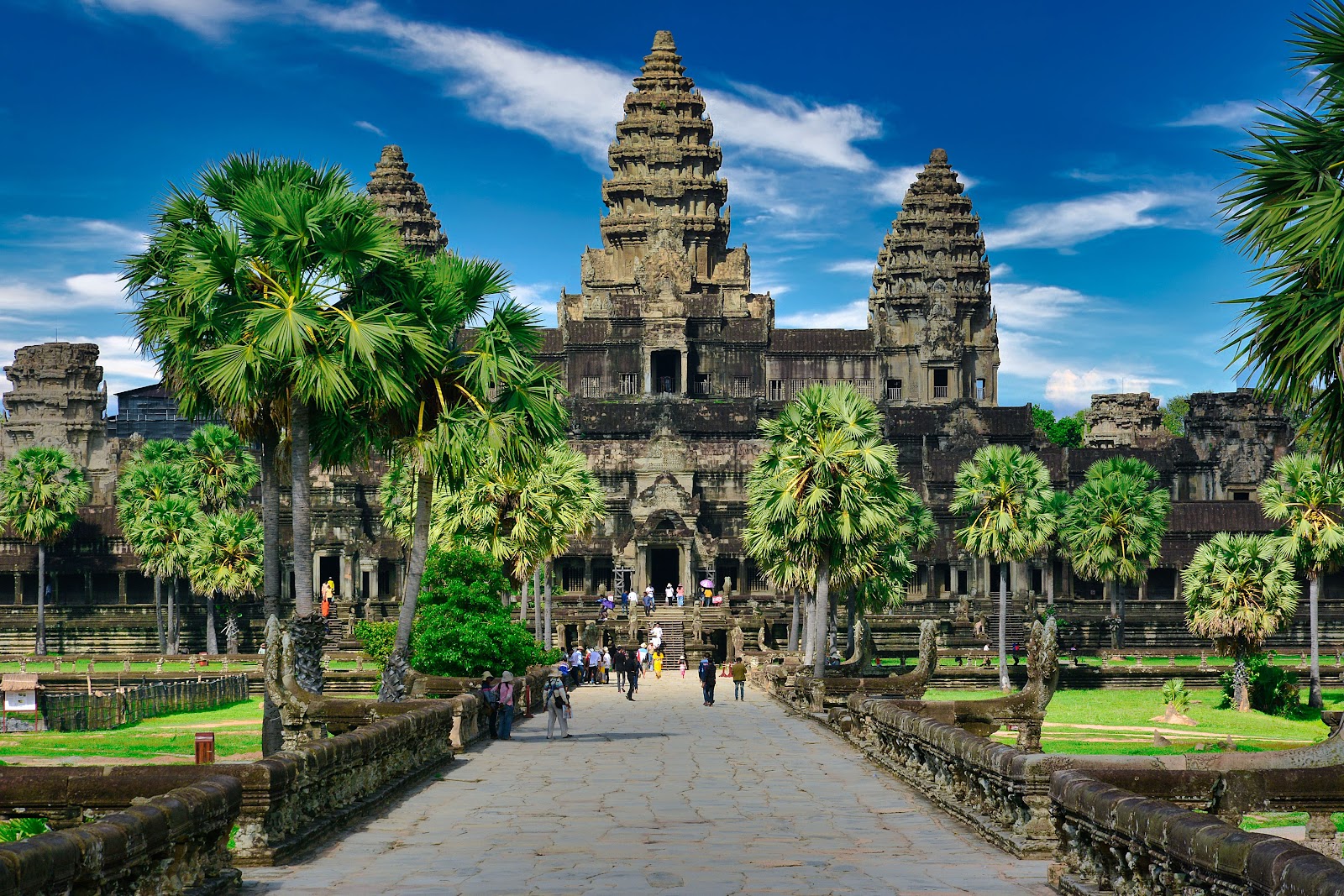
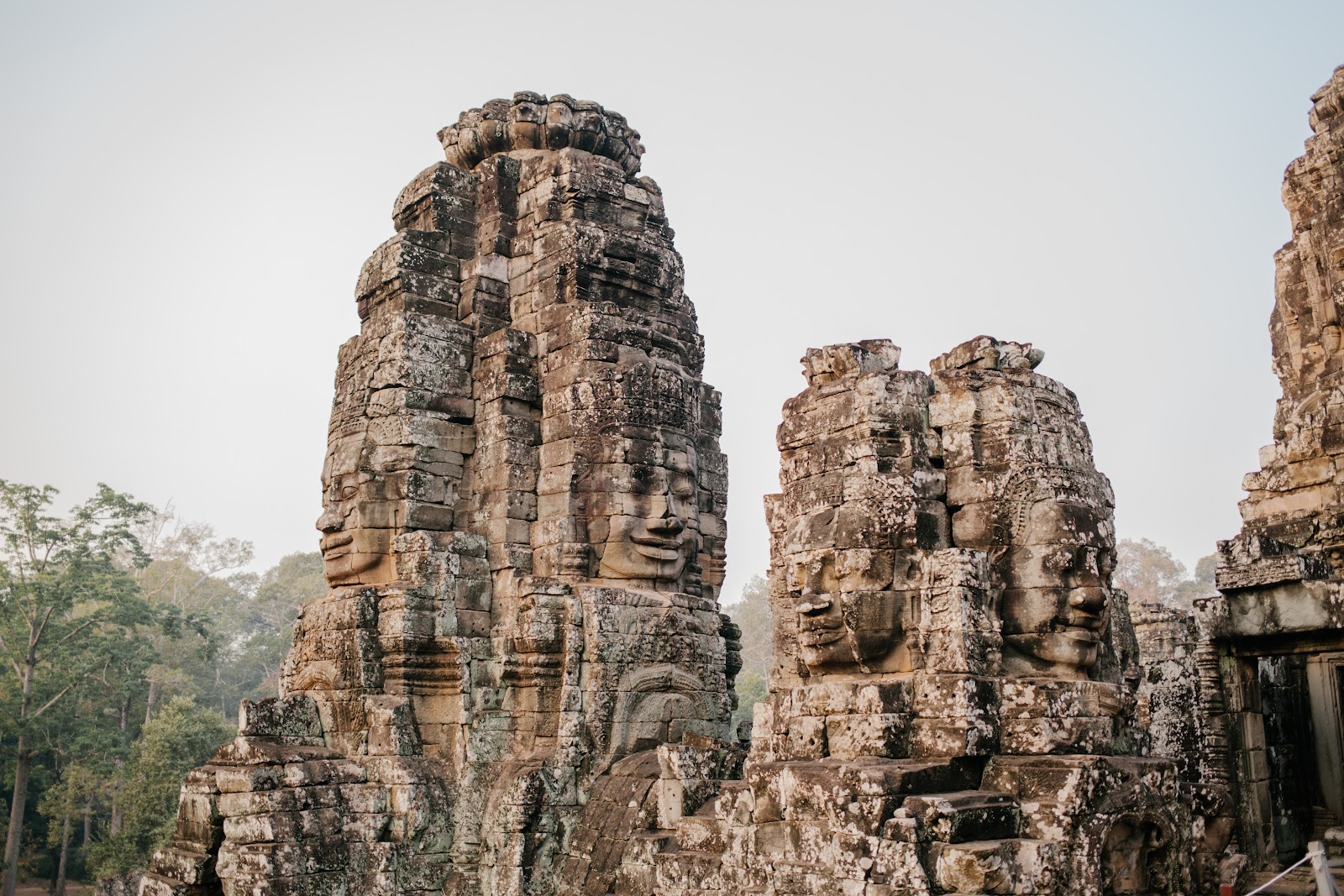
Bayon
Bayon is located at the heart of Angkor Thom, the last and largest capital city of the Khmer Empire. It was built in the late 12th century by King Jayavarman VII as a Buddhist temple that also incorporated elements of Hinduism and animism. He was a benevolent and devout ruler who rebuilt the empire after a devastating invasion by the Chams, and promoted social welfare and religious tolerance. Bayon is famous for its 216 giant stone faces that adorn its 54 towers, each with a serene and mysterious expression. The faces are believed to represent either Jayavarman VII himself or Avalokiteshvara, the bodhisattva of compassion. Bayon also features elaborate bas-reliefs that depict scenes of everyday life, warfare, mythology, and history. The temple covers an area of about 3 hectares (7 acres) and has three levels that represent different realms: the underworld, the human world, and the celestial world.
Banteay Srei
Banteay Srei is located about 25 km (16 miles) northeast of Angkor. It is considered by many to be the jewel in the crown of Angkorian art, as it is cut from stone of a pinkish hue and includes some of the finest stone carvings in Cambodia. It was built in 967 by a courtier named Yajnavaraha as a Hindu temple dedicated to Shiva. He was a scholar and philanthropist who served under two kings: Indravarman I and Yasovarman I. Indravarman I built the first large-scale irrigation system and temple mountain at Angkor, while Yasovarman I moved the capital to Angkor and established the city of Yasodharapura around a central temple called Phnom Bakheng. Banteay Srei is also known as the Citadel of Women or the Citadel of Beauty, due to its delicate and intricate design. The temple covers an area of about 0.8 hectares (2 acres) and consists of three concentric enclosures that contain three towers each. The carvings depict scenes from Hindu epics such as the Ramayana and the Mahabharata.
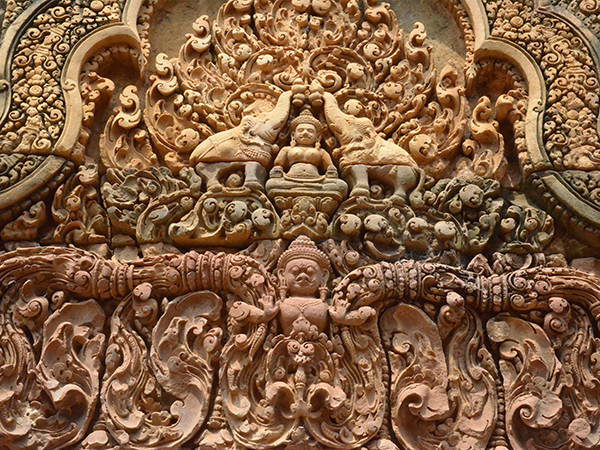
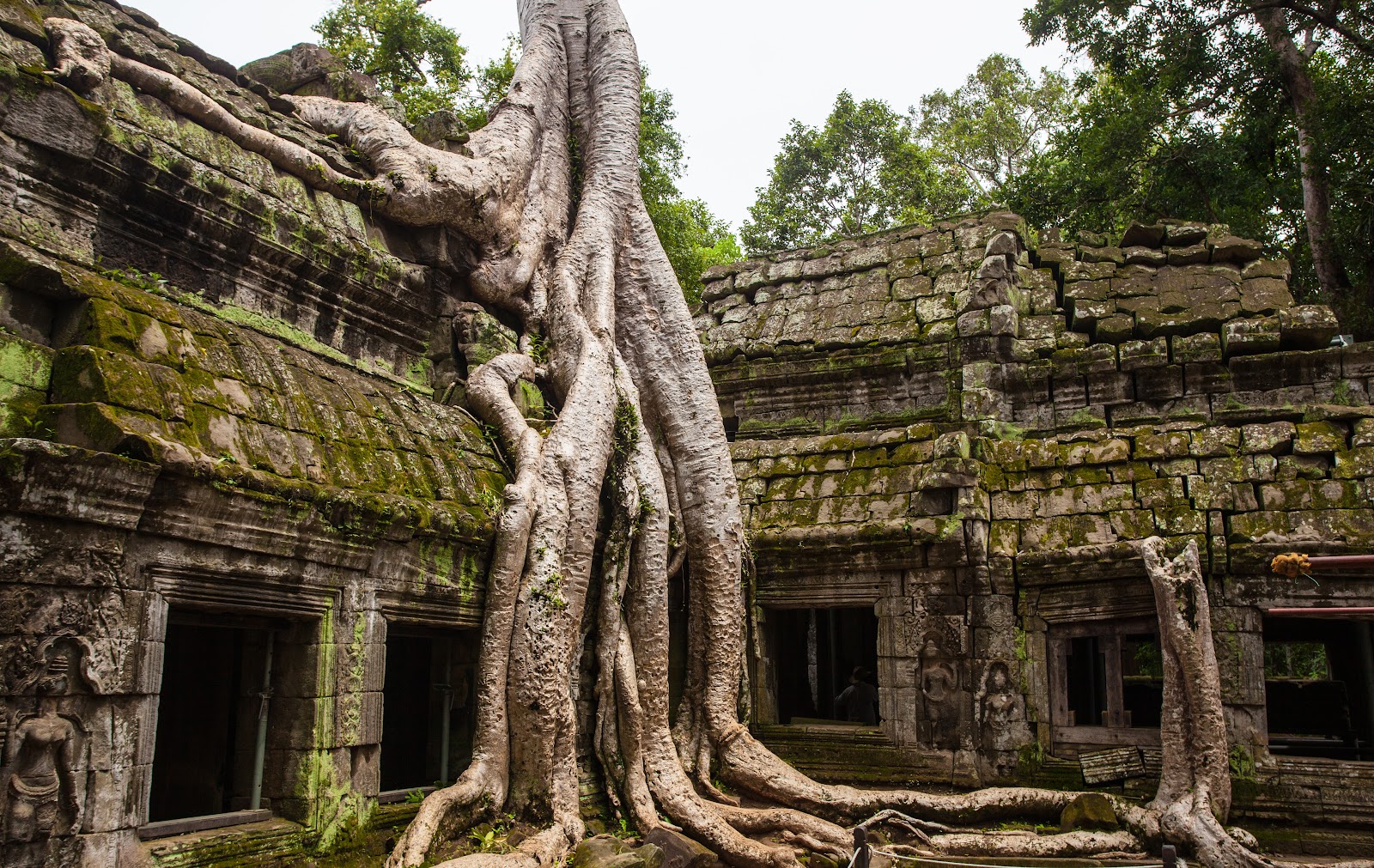
Ta Prum
Ta Prum is a Buddhist temple near the city of Siem Reap, Cambodia, covering an area of about 2.5 hectares (6 acres). It was built in the late 12th and early 13th centuries by King Jayavarman VII as a monastery and center of learning dedicated to his mother. He was a compassionate and generous ruler who restored the empire after a civil war and established a network of hospitals, rest houses, and reservoirs. He also promoted Mahayana Buddhism as the state religion and built many temples in its honor.
Ta Prum is famous for its atmospheric ruins that are engulfed by the jungle. The temple has been left largely untouched by restoration efforts, allowing visitors to experience its original charm and mystery. The temple consists of five enclosures that contain galleries, towers, courtyards, and shrines. The walls are decorated with bas-reliefs that depict scenes from Buddhist legends and history. The most striking feature of Ta Prum is the presence of giant trees that have grown over the stones, creating a symbiotic relationship between nature and culture.
Ta Prum is not only a remarkable example of Khmer engineering, but also a sacred place of worship for Buddhists today. It is one of the most popular temples in Angkor, attracting millions of tourists every year. It is also known as the Tomb Raider Temple, because it was featured in the movie Lara Croft: Tomb Raider starring Angelina Jolie.
The Cardamom Mountains: A Wilderness Adventure
The Cardamom Mountains, or the Krâvanh Mountains, is a mountain range in the southwest of Cambodia and eastern Thailand. The majority of the range is within Cambodia and is the largest remaining rainforest in Southeast Asia. The mountains are home to a variety of wildlife, including elephants, tigers, sun bears, Siamese crocodiles, gibbons and clouded leopards. The mountains also hold many historic sites from the 15th to 17th century, such as jar burials that are scattered on remote rock ledges.
The Cardamom Mountains are a great destination for adventure seekers who want to explore the rugged landscape, the dense forest, and the gushing rivers. There are several options for hiking, trekking, camping, and kayaking in the area, as well as wildlife watching and community-based tourism. One of the best ways to experience the Cardamom Mountains is to stay at the Cardamom Tented Camp, an eco-camp that is located inside Botum Sakor National Park. The camp offers nine comfortable safari-style tents that minimize the human footprint on the natural world and serve as a role model in promoting sustainable tourism practices in the park and within Cambodia as a whole.
The camp also works with Wildlife Alliance (WA), a nature organization that rescues animals from poachers and traffickers and rehabilitates them at Phnom Tamao Rescue Centre. Some of the animals are then released back to their natural habitat at WA's wildlife release stations in the heart of the Cardamom Mountains. Guests at the camp can join rangers on their mission and get up close and personal with some of these incredible animals.
The Cardamom Mountains are truly a land of beauty and wonder, where visitors can enjoy the best of both worlds: wilderness adventure and wildlife conservation. It is also a place where visitors can experience the rich heritage and culture of Cambodia, as well as its delicious cuisine. The Cardamom Mountains are definitely one of the most attractive regions in Cambodia for travelers who want to discover its diverse charms.
The South Coast: A Tropical Paradise
Cambodia's south coast offers a variety of attractions for beach lovers, nature enthusiasts, and adventure seekers. The region boasts some of the most pristine and picturesque beaches in the country, as well as several islands that are ideal for relaxing, snorkeling, diving, and partying. The south coast is also home to some of the country's most important national parks and wildlife sanctuaries, where visitors can explore the rich biodiversity and natural beauty of Cambodia.
One of the most popular destinations on the south coast is Sihanoukville, a bustling city that serves as the gateway to many of the nearby islands. Sihanoukville has several beaches to choose from, each with its own vibe and character. Ochheuteal Beach and Serendipity Beach are the most lively and crowded, with plenty of bars, restaurants, and nightlife options. Otres Beach and Independence Beach are more laid-back and serene, with fewer crowds and more space. Ream Beach and Sokha Beach are more secluded and pristine, with clear water and white sand.
From Sihanoukville, visitors can take a boat to one of the many islands that dot the Gulf of Thailand. Some of the most popular ones are Koh Rong, Koh Rong Sanloem, Koh Tonsay, Koh Thmei, and Koh Ta Kiev. Each island has its own charm and appeal, depending on what visitors are looking for. Koh Rong is the largest and most developed island, with a vibrant party scene on Koh Tuch Beach and more tranquil spots on Long Set Beach and Sok San Beach. Koh Rong Sanloem is a smaller and quieter island, with a stunning crescent-shaped beach on Saracen Bay and a few rustic resorts on Lazy Beach and Sunset Beach. Koh Tonsay is a tiny island that offers a simple and authentic experience of living in a fishing village, with basic bungalows and hammocks on the beach. Koh Thmei is part of Ream National Park, a protected area that hosts a variety of wildlife, such as dolphins, monkeys, birds, and turtles. Koh Ta Kiev is an off-the-beaten-track island that attracts backpackers and nature lovers who want to camp or stay in treehouses.
The south coast is not only about beaches and islands, though. It also has some charming towns that are worth visiting for their history, culture, and cuisine. Kampot is a riverside town that is famous for its pepper plantations, colonial architecture, and scenic views of Bokor Mountain. Kep is a seaside town that was once a fashionable resort for the French elite and now attracts visitors with its fresh seafood, especially crab. Both towns are also gateways to some of the natural attractions in the area, such as Bokor National Park, Kep National Park, Peam Krasaop Wildlife Sanctuary, Phnom Da Temple, and Phnom Chhnork Cave.
The south coast of Cambodia is truly a land of beauty and wonder, where visitors can enjoy the best of both worlds: tropical beaches and islands on one hand, and lush forests and mountains on the other. It is also a place where visitors can experience the rich heritage and culture of Cambodia, as well as its delicious cuisine. The south coast is definitely one of the most attractive regions in Cambodia for travelers who want to discover its diverse charms.
Phnom Penh: The Cultural and Commercial Hub
Phnom Penh is the capital and largest city of Cambodia, a country with a rich and diverse heritage and culture that spans over three millennia. Cambodia has been influenced by various civilizations, such as India, China, France, and Vietnam, but has also developed its own distinctive identity and creativity. Cambodia’s heritage and culture can be seen in its architecture, art, literature, music, dance, religion, cuisine, and customs.
Phnom Penh is situated at the confluence of the Mekong and Tonle Sap rivers, and has been a prosperous trading port since the French colonial rule in the 19th century. The city has undergone many changes and transformations throughout its history, from being a tragic site of genocide under the Khmer Rouge regime in the 1970s to being a revitalized city that offers a mix of modern and traditional attractions for visitors today.
One of the most important landmarks in Phnom Penh is the Royal Palace, which serves as the official residence of King Norodom Sihamoni and his family. The palace was built in 1866 by King Norodom I and features several buildings with distinctive Khmer architecture and ornate decoration. The most notable among them are the Throne Hall, where official ceremonies take place; the Silver Pagoda, which houses a collection of priceless Buddha statues; and the Moonlight Pavilion, which overlooks a manicured garden.
Another attraction in Phnom Penh that should not be missed is the National Museum of Cambodia, which houses the largest collection of ancient Khmer art and artifacts in the country. The museum was built in 1920 and displays more than 1,800 objects dating from the pre-Angkorian to the post-Angkorian periods. The highlights of the museum include the Vishnu head from Angkor Wat, the statues from Koh Ker and Angkor Thom, and the pre-Angkorian artifacts from Funan and Chenla.
A third attraction in Phnom Penh that should not be skipped is the Tuol Sleng Genocide Museum, which was once a high school turned into a notorious prison and torture center by the Khmer Rouge. The museum preserves the evidence of the atrocities committed by the regime, such as photographs, documents, instruments, and cells of the victims. The museum also honors the memory of the estimated 17,000 people who perished here between 1975 and 1979.
Besides these historical and cultural attractions, Phnom Penh also offers a variety of culinary experiences for visitors. The city is known for its diverse and delicious cuisine, influenced by Khmer, Chinese, Indian, Thai, Vietnamese, and French traditions. Some of the dishes to try in Phnom Penh include amok (fish or chicken cooked in coconut milk and spices), kuy teav (noodle soup with pork or seafood), bai sach chrouk (rice with grilled pork and pickles), nom banh chok (rice noodles with fish curry), and lok lak (stir-fried beef with lime sauce). For dessert, don’t miss the tapioca pudding with coconut and sweet corn, or the black sticky rice crème brûlée.
Phnom Penh is not only a cultural and commercial hub of Cambodia, but also a gateway to explore other parts of the country. One of them is the Angkor World Heritage Site in Siem Reap province, which was the capital of the Khmer Empire from the 9th to the 15th century. The Angkor period was a golden age of Khmer culture and power, as seen in the magnificent temples, sculptures, and inscriptions that still awe visitors today. Angkor Wat, the largest religious monument in the world, is a symbol of Cambodia’s national pride and a UNESCO World Heritage Site. Angkor Wat was built in the 12th century by King Suryavarman II as a Hindu temple dedicated to Vishnu. It is renowned for its intricate carvings, soaring towers, and symmetrical layout. It is also surrounded by a moat that symbolises the cosmic ocean.
Another remarkable temple at Angkor is Bayon, located at the heart of Angkor Thom, the last and largest capital city of the Khmer Empire. Bayon was built by King Jayavarman VII in the late 12th century as a Buddhist temple that also incorporated elements of Hinduism and animism. It is famous for its 216 giant stone faces that adorn its 54 towers, each with a serene and mysterious expression. The faces are believed to represent either Jayavarman VII himself or Avalokiteshvara, the bodhisattva of compassion. Bayon also features elaborate bas-reliefs that depict scenes of everyday life, warfare, mythology, and history.
A third temple worth mentioning is Banteay Srei, located about 25 km (16 miles) northeast of Angkor. Banteay Srei is considered by many to be the jewel in the crown of Angkorian art, as it is cut from stone of a pinkish hue and includes some of the finest stone carvings in Cambodia. It was built in 967 by a courtier named Yajnavaraha as a Hindu temple dedicated to Shiva. It is also known as the Citadel of Women or the Citadel of Beauty, due to its delicate and intricate design.
Angkor is not only a reflection of the Khmer Empire’s glory and achievements, but also of its syncretism of Hinduism and Buddhism that shaped Cambodian beliefs and values. Angkor also represents the resilience and creativity of the Cambodian people, who have survived and rebuilt their country after centuries of war, genocide, and foreign intervention.
Phnom Penh and Angkor are just two examples of Cambodia’s rich and diverse heritage and culture that span over three millennia. Cambodia has much more to offer to visitors who want to discover its history, beauty, and charm. Cambodia is a country that deserves respect and admiration for its past, present, and future.
The Northeast: A Land of Diversity
The northeast of Cambodia is a land of diversity, where visitors can encounter different ethnic groups, landscapes, and wildlife. The region comprises four provinces: Ratanakiri, Mondulkiri, Kratie, and Stung Treng. Each province has its own charm and appeal, depending on what visitors are looking for.
Ratanakiri is the most remote and rugged province in Cambodia, known for its volcanic lakes, waterfalls, mountains, and forests. It is also home to several indigenous groups, such as the Jarai, Tampuan, Kreung, and Brao, who have their own languages, cultures, and traditions. Visitors can learn about their way of life by staying in a homestay or visiting a community-based tourism project. Ratanakiri is also a great place for adventure activities, such as trekking, biking, kayaking, and wildlife watching.
Mondulkiri is the largest and least populated province in Cambodia, famous for its rolling hills, pine forests, coffee plantations, and elephants. It is also home to several indigenous groups, such as the Phnong, Kuy, Stieng, and Punong, who have their own languages, cultures, and traditions. Visitors can learn about their way of life by staying in a homestay or visiting a community-based tourism project. Mondulkiri is also a great place for adventure activities, such as trekking, biking, camping, and elephant interaction.
Kratie is a riverside province that offers a glimpse of rural life along the Mekong River. It is best known for its endangered Irrawaddy dolphins, which can be seen in a stretch of the river between Kratie town and Kampi village. Visitors can take a boat or kayak tour to spot these gentle creatures. Kratie is also a good base to explore some of the nearby attractions, such as Koh Trong island, Phnom Sambok pagoda, Sambor Prei Kuk temple complex, and Kampi rapids.
Stung Treng is another riverside province that lies at the confluence of the Mekong and Sekong rivers. It is a gateway to some of the natural attractions in the area, such as the Mekong Falls (also known as Khone Phapheng Falls), the largest waterfall in Southeast Asia; the Ramsar Wetlands (also known as Stung Treng Ramsar Site), a protected area that hosts a variety of flora and fauna; and the Virachey National Park (also known as Veun Sai-Siem Pang National Park), a vast wilderness area that harbors many endangered species.
The northeast of Cambodia is truly a land of diversity,
The Nature and Biodiversity of Cambodia
Cambodia is one of the most biodiverse countries in Southeast Asia, with more than 8,000 plant species, 250 reptile and amphibian species, 874 fish species, and 500 bird species. The country also hosts many endangered and endemic species, such as the Asian elephant, the Siamese crocodile, the wild water buffalo, and the Germain's silver langur. Cambodia's nature and biodiversity are influenced by its geography, climate, and history.
Cambodia has a variety of ecosystems, such as tropical rainforests, dry deciduous forests, mangroves, wetlands, grasslands, and coral reefs. Some of the most important natural areas in Cambodia are the Cardamom Mountains, the largest remaining rainforest in Southeast Asia; the Tonle Sap Lake, the largest freshwater lake in Southeast Asia; the Mekong River, one of the longest and most biodiverse rivers in the world; and the Koh Kong Archipelago, a group of islands with rich coral reefs.
Cambodia's nature and biodiversity are also affected by its climate, which is characterized by a monsoon cycle. The rainy season lasts from May to October, when the southwest monsoon brings heavy rains and floods. The dry season lasts from November to April, when the northeast monsoon brings cooler and drier weather. The climate creates a fertile floodplain that supports a large population of fish and birds.
Cambodia's nature and biodiversity have also been shaped by its history, which has been marked by periods of prosperity and decline. The Angkor civilization (9th-15th century) was a powerful and influential empire that built many temples and monuments that are now part of Cambodia's cultural heritage. The Angkor period also witnessed deforestation and irrigation that altered the natural landscape. The colonial period (1863-1953) saw the introduction of new crops and animals that affected the native flora and fauna. The civil war and genocide (1970-1979) caused massive destruction and displacement that harmed the environment and wildlife. The post-conflict period (1980-present) has seen efforts to restore and conserve Cambodia's nature and biodiversity through various initiatives and organizations.
Cambodia's nature and biodiversity are precious resources that provide many benefits to its people and the world. They contribute to food security, water supply, climate regulation, tourism, culture, and education. They also face many threats from deforestation, habitat loss, poaching, illegal wildlife trade, pollution, climate change, and development. It is therefore important to protect and sustain Cambodia's nature and biodiversity for present and future generations. Conclusion (prompt : please write a heartfelt conclusion. One where the it will move the readers to tear after reading)
Cambodia is a country that has endured many hardships and challenges, but has also shown remarkable resilience and strength. It is a country that has a rich and diverse heritage and culture that spans over three millennia and reflects the influences of various civilizations. It is a country that has a stunning and diverse nature and biodiversity, that hosts many rare and endemic species and ecosystems. It is a country that has warm and hospitable people, who welcome visitors with smiles and generosity.
Cambodia is a country that deserves our respect and admiration, but also our support and solidarity. It is a country that faces many threats and problems, such as poverty, corruption, human rights violations, environmental degradation, and climate change. It is a country that needs our help and cooperation, to preserve its heritage and culture, to protect its nature and biodiversity, to improve its development and governance.
Cambodia is a country that has touched our hearts and minds, with its beauty and wonder, with its history and stories, with its spirit and soul. It is a country that we will never forget, and that we will always cherish. It is a country that we hope to see again, and that we hope to see thrive. Cambodia is a country that we love.
